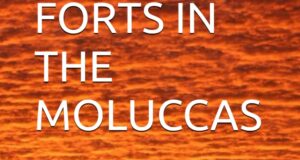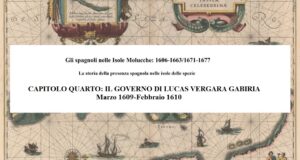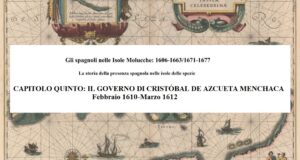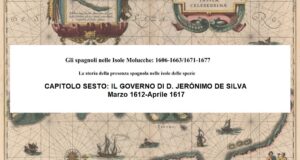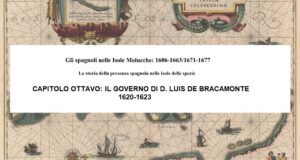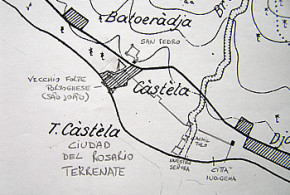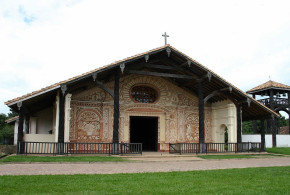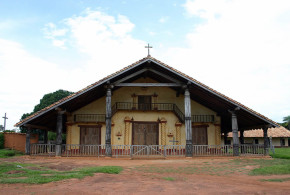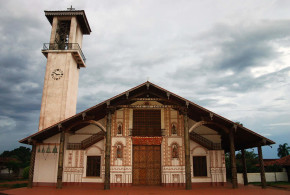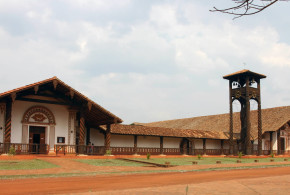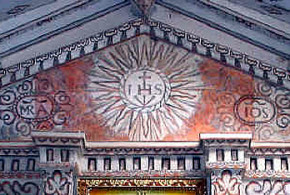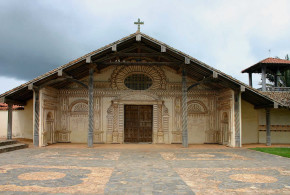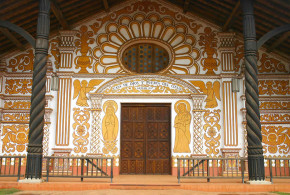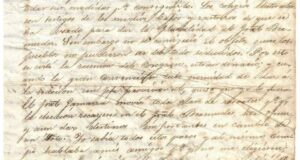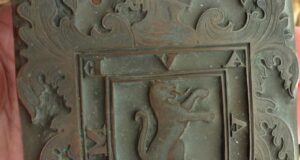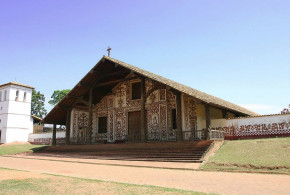This post is also available in:
![]() Italiano
Italiano
Written by Marco Ramerini 2000-2007/2023
6.4 – RUME
Spanish: Rume, Rum, Rumen1, El Rume, San Lucas de el Rume, San Lucas del Rumen2: (Current name: Rum)
CHRONOLOGY: Spanish: November 1618-May/June 1663
Dutch: Roemy3, Roumy4, Romi5, Roumi6, Roemij7, Roumij8, Roemi, Romy9
A mention of the port of Rume was already made in 1585 in the report of the friar Cristoval Salvatierra: ‘…el armada de los españoles que estaua junto a la tierra de Terrenate, entre ella y la isla de Tidore donde con otro yslotillo questaua entre medias haze muy buen puerto esta a la vista de la fortaleza de Terrenate y dos leguas de la de Tidore llamase este puerto el Rume’. 10
The place where the Spaniards built the Rume fort was located in the north-western part of the island opposite the island of Maitara and dominated the narrow channel between Tidore and Ternate, furthermore here was the best port11 on the island of Tidore where boats often Europeans stopped.
In November 1618, the Spaniards, led by the governor of Ternate Lucas Vergara Gabiria built a fort which was called San Lucas de el Rume in honor of the governor.12 To inform us in detail of the events that led to the construction of the fort is an eyewitness, the Franciscan friar Gregorio de S. Esteban.
The fort of Rume was built following a letter from the king of Tidore sent to the governor Vergara and delivered to the same governor by the prince of Tidore Cachil Naro, in which the king asked the Spaniards to build a Spanish fortress in a place, next to the Dutch fort of Marisco (Marieko), where the Portuguese had already established themselves ‘que construyera una fortaleza en un lugar próximo á la fuerza de los holandeses de Marisco, donde ya habían estado establecidos los portugueses’, in order to encircle the Dutch (who had their fort in Marieko) and to prevent them from harvesting cloves which were produced in abundance in that area of the island.
Vergara at the head of 150 Spaniards and many Indian soldiers and accompanied by Cachil Naro and two Franciscans, Fr. Pedro de los Cobos and Fr. Gregorio de S. Esteban, on November 23, 1618, founded the fort of S. Lucas de el Rume, the fort was built on a high place, where Dutch artillery shots could not reach. In fact, during the construction of the fort, the Dutch attempted an attack against the Spaniards, which however had no practical result precisely because of the dominant position of the place chosen by the Spaniards for the construction of the fort. The fort was named San Lucas in honor of the governor who founded it: Lucas de Vergara.13
Fr. Gregorio de S. Esteban also leaves us an interesting description of the Spanish and Dutch forts present in recent years on the arm of the sea between the islands of Ternate and Tidore: ‘Es Terrenate un volcan redondo; el pueblo y ciudad de Terrenate está á la banda de el sur, Tacome á la banda del norte, Malayo á la banda del este, y costeando hacia el sur, está el puerto que llaman de Talangamé, y un poco más adelante está el puerto que tratamos de Calomata, y un poco más adelante nuestra fuerza de Dongil. De la otra banda está la isla de Tidore, que tambien es un volcan redondo y alto, pero tiene hacia la parte del norte, que cae hacia Malayo, una grande falda con unos mogotes grandes, y enesta parte está nuestro fuerte de S. Lucas, suerte que están mirando S. Lucas y Calomata, pero está la mar en medio, y es la travesia de una isla á otra, la más corta, un tiro de cañon, aunque las fuerzas están muy desviadas. Junto á la isla de Tidore y cerca de S. Lucas está otra isla pequeña, que se llama Meytara, de suerte que está en medio de Tidore y de Terrenate, pero mas llegada á la isla de Tidore que de Terrenate, y así hace dos brazos de mar, el uno más estrecho que el otro, fondeables; el uno le guarda nuestra fuerza de Dongil y el otro le guarda el fuerte de S. Lucas; pues para estorbar nuestras embarcaciones que no fuesen á S. Lucas, tomaron el puerto de Calomata, que tambien alcanza con su artilleria á la isla de Meytara. El otro brazo de hacia Tidore, tambien lo guarda la fuerza de Marisco que está alli junto’14
The fort of Rum is represented in an interesting sketch of the west coast of Tidore, preserved in the University Library of Leiden, and drawn by an anonymous Dutch soldier or sailor. In it the Spanish fort of Rum is called Rúmo. The fort, which from the representation appears to be a small fort or a casemate, is located high on a hill near the sea, it is covered by a gabled roof and has a square shape. On the south side outside the fortification stands the Spanish flag (this is the characteristic flag with the Burgundy cross, used by Spanish infantry troops in the 16th-17th centuries). There are a few lines of description next to the fort with the following sentence: ‘Rúmo. Hier hadde den Spaignard @ j621 een cleyne vastich.t‘, i.e. ‘The Spanish had a small fortification here in 1621’.15
Some other Spanish documents deal extensively with this fort citing soldiers or captains who had served in the fort: Vergara himself describes Rume as a fortification located in the vicinity of Marieco: ‘…fuerza del Rumē sercana a la del enemigo Olandes y Terrenate de Marieco …’ , Vergara, sent Rodrigo de Mesa to garrison the Rume fort, with the position of governor of the company of the captain and sergeant major Alonso Martin Quirante. Rodrigo de Mesa was probably one of the first to have command of this fort.16 The ensign Pedro de Mora Salcedo, around 1621, served with his company ‘enlas fuerças del Rume‘ (which suggests the existence of two forts), then since his captain (perhaps Francisco Ximenes) had been in charge of to travel to the city of Tidore, Pedro de Mora Salcedo was temporarily given charge of the fort.17 Around 1625-1626 the captain Esteban de Somoza y Losada was appointed head of the forts of the ‘Rrume‘ where he remained for a few months.18
Other interesting information on the Rume fort and a cross-section of the events that concerned the life of the fort are present in various other documents: on 23 August 1632, Pedro de Heredia, who had had a sight conversation with the king of Tidore, had been informed by the king of the intention of the Dutch to attack the fort of Rume, Heredia, informed of this Alonso Serrano, who was in garrison and head of the fort of Rume with most of his company. Since there were three posts to watch and garrison at the Rume (evidently the two platforms and the fort at the top), Heredia sent another 20 soldiers commanded by Captain Andres de Azcueta Menchaca to garrison the fort and its platforms.
The command of the fort remained in the hands of Alonso Serrano, Azcueta with his soldiers had to garrison one of the platforms. Subsequently, a letter from the king of Tidore informed Heredia of the risk of possible rebellion by the Tidorese, for which the forts of Tidore and Rume were put on alarm (on 17 September 1632), and it was ordered not to admit anyone ‘moro‘ inside the Spanish forts.
On October 18, 1632, an order from Heredia informed Alonso Serrano that if any boat of ‘mori‘ arrived with a white flag to negotiate they were to be captured or killed, because they were enemies. It seems that an ‘indio‘ from Rume had made an agreement with the enemies to betray the Spaniards. In the paper dated November 18, 1632, it seems to read between the lines that Pedro de Heredia also suspected the treachery of the king of Tidore.
In fact, the king of Tidore wanted to withdraw some of the 70 Tidorese soldiers present in Rume, but Pedro de Heredia ordered Serrano to keep at least 40 Tidorese in the garrison, because he suspected that the king wanted to weaken the Spanish defenses. In case of attack Heredia advised Serrano to keep the ‘Jacalos‘ under the high fort (‘da ariua‘) and the platform below so that the Spaniards would have nothing to fear.
To divert the enemy Heredia intended to carry out a diversionary maneuver (perhaps in Ternate?), for the purpose he needed Serrano to send him the ‘guilalo‘ (a type of boat?) as armed as possible with some pampangos and 10 soldiers of the bravest on board, what Heredia wanted to do he does not say because he feared leaks, he informs Serrano (head of the forces of Rumen), that only he and the one who will have to command the troops knew the plans of the attack.
A new paper by Pedro de Heredia dated December 5, 1632 informed Serrano that Heredia had the intention of bringing the number of soldiers garrisoning the Rume fort back to 40 men as it was in the past. From this document it appears that the danger had passed.
Another paper dated December 11, 1632, presents us with an inverted situation, in fact Heredia had received information from a wounded ‘moro Rumen‘, who had fled from the Spaniards three months earlier and who had passed over to the enemies, but who had been captured again by the Spanish, that the king don Pedro (the sultan of Ternate Cachil Hamja, called by the Spanish don Pedro de Acuña) had the intention of capturing the fort of the Rumen, moreover it seems that he wanted to fortify Tacome.
Pedro de Heredia suspected that the enemy wanted to attack the Rume by way of Chouo, for from there it was an easy path that led to the Rumen, which was located only a quarter of a league away from Chovo. Orders were to post more sentries (half a dozen) on the side from which the enemy was expected to arrive.
Interesting is the Heredia paper of December 15, 1632, which informs us that the garrison of the Rumen forces were, included Alonso Serrano, 71 Spaniards, furthermore another 21 soldiers were subsequently sent from Ternate which brought the total of the garrison to 92 Spaniards, in addition, another gunner was sent in the brigantine that had brought the message. Thanks to the prevention made by Alonso Serrano, Heredia thought that neither the Dutch nor the Ternese had dared to attempt to land troops, but otherwise he judged the fort well defended. For that night Heredia ordered the ‘Indians‘ of the village of Rume to be kept inside the fort as well. During the following night, however, Heredia ordered the sentries to be doubled, and if the ship and the enemy caracoras did not take any action by the following morning, the brigantine was to be sent to Ternate so that the remaining troops could be sent the next day to the Rume, so that in the garrison of the Rume there were many more than the 40 soldiers who normally garrisoned the place.19
In 1643, Lope de Colindres, being a soldier in the company of the master of the field don Lorenço de Olasso, embarked with him for Ternate, where he was in charge of the fort of San Lucas del Rumen.20 In the same period Juan Camacho de la Peña was commissioned to take care of the fortification works of the ‘fuerça de Chouo‘ and the arrangement of the port of Rume.21 Both posts were put into a state of defence. Around 1650, Captain Martin Sanchez de la Cuesta was sent by order of Governor Pedro Fernandez del Rio to the forts of San Lucas del Rumen and Chobo.22
From the reading of some documents it is evident that the fortifications of Rume consisted of two distinct defensive works, one located at the level of the beach and the other above the hill overlooking the port and the canal between Tidore and Ternate. Pedro Bravo de Acuña, for example, after having been, in the years 1627 and 1628, head of the infantry of one of the galleys. He later became head of one of the two platforms of the port of Rumen.23 In the years 1653-1654, under the government of Francisco de Esteybar, the Spaniards rebuilt the ‘rretirada‘ of the fort of San Lucas del Rumen (i.e. the topmost fortification), having been of ‘madera vieja y podrida‘ they rebuilt it of ‘cal y canto‘, this operation made very difficult also due to the conformation of the land on which the fortification was located and the and the steep slope.24
The importance of the port of Rume is also highlighted in a series of documents dated between June and July 1650 and signed by the governor Francisco de Estaybar. The governor speak of the works to ‘aderejar’ the galley, and where Esteybar informs us that such works would have been done in the port of Rumen.
The galley probably had a leak and the Spaniards were repairing it. The king of Tidore was also to come to visit the works on the galley, in a note in response to a request from Miguel de Guinea on how to behave upon the king’s arrival, Esteybar informed him that when the king’s boat was sighted three salvos of artillery was to be fired from Chovo’s fort and later also from his galley.
Two rafts were built for the transport of the ‘monara‘ which was in Don Xil and which had to be transported to the Rume where the galley was anchored. For dragging the rafts, the Spaniards thought of using two ‘barcos‘. Esteybar absolutely forbade the galley to leave said port to drag the rafts. It was also forbidden for the galley crew to collect the ‘monaras‘. Captain Melchor took charge of transporting the ‘monara‘, collected on two rafts.
In the opinion of Diego Rodriguez however, in this period, it was better to use the port of Chovo where the galley was safer and where the crew could subsist on papaya and other local fruit (this information is interesting because it eliminates any doubt that Rume and Chobo could be the same fortifications). The advice of Diego Rodriguez was evidently followed and the galley was moved to the port of Chovo where the works were started, in fact, subsequently, Esteybar expressed his concern for the galley, since the wind had changed and the season had been bad. Esteybar wondered if it wasn’t the case to move the galley from the port where it was (Chobo?) to the Rumen.25
The Spanish troops will occupy the fort continuously from its foundation until the abandonment of their garrisons in the Moluccas. In 1663, when they left, the fort was only partially dismantled. And it is the last one that the Spaniards abandoned, in fact its port was used as a gathering point for Spanish boats after the city of Ternate and the other garrisons were destroyed and set on fire. In accordance with the orders of Manrique de Lara, the dismantling of the Spanish forts had to follow a precise criterion which was to transport all the material (ammunition, artillery, etc.) removed from the dismantled forts “alas fuerzas del Rumen”26 in the island of Tidore, which was to be the last place to be demolished, because it was here that was the most important and safest port in the hands of the Spaniards.27 From the correspondence between Atienza and the Dutch governor of Ternate, Antonio Van Voort, it is clear that the Spaniards abandoned the city of Ternate on May 29, 1663, moving to Rume from where they wrote several letters dated May 30, 1663. Therefore it seems plausible that among the last day of May and the first days of June 1663, the last Spanish troops left the island of Tidore. According to what Jacobs reports, on June 2, 1663, the Spanish abandoned the forts of the Moluccas, to concentrate all their forces on the defense of Manila. It was the last episode of a relationship that began 142 years earlier with the arrival in Tidore of Magellan’s expedition on November 8, 1521.28
Soon after the Spanish departure, the king of Tidore occupied the forts on his own island which the Spanish had abandoned and attempted to destroy. A contingent of 40-50 soldiers of the king occupied the fort of Rum (Romi) at the time when the Spanish were leaving. On 18 June at the invitation of the king of Tidore, the Dutch commander visited the Spanish fort of Rum (Romy) together with the king, finding it in excellent condition, only the staircase and the balconies of the upper fort had been destroyed, some buildings had been filled with wood by the Spaniards with the clear intention of burning everything before leaving, but something or someone (probably the Tidorese) had prevented them from carrying out their plans. According to the Dutch report, the fort of Rum (Romy) consisted of a fortification at the level of the beach called “the platform” which continued upwards in a triangular shape, completing this structure were three small redoubts. Even the upper fort was in good condition and kept its walls intact, on the side facing the sea there was also an iron cannon.29
The report of Father Miguel de Pareja, dated 1670, describes in a catastrophic way the state of the fort of ‘Rumen‘ of which, according to his testimony, not a single stone remains, all transported to Ternate to be used in the fortification works of the Dutch. Pareja even states that even the place where the fort was located is, even to the most practical, unknown. As we have seen, the reports drawn up by the Dutch in the same years inform us that a large part of the fort is still intact.30
One of the few “recent” descriptions of the Rume fort is the description that Van de Wall gives us in his book “De Nederlandsche oudheden in de Molukken” where however several inaccuracies are reported: the fort was located on a hill above the beach in the eastern part of the island (this is certainly an error, in fact Rum was in the north-western part, to corroborate this hypothesis, is the fact that a few lines further on Van de Wall tells us that the cannons of the fort covered the strait between Tidore and Malayo). The bay where the fort was located was undoubtedly the best port on the island. The fort was square in shape and was armed, in 1627, with 4 cannons. Under the fort, on the beach, a crescent was built where 5 cannons were mounted to protect both the ships moored in the port and the sea strait between Tidore and Malayo.
According to Van de Wall, the fort was built by the Portuguese and conquered by the Dutch in 1605 (to date, in the documents I have consulted, I have not found any mention of a Portuguese fort in Rum, it seems that van de Wall confuses (as indeed also does Valentijn) the fort of Rum with the fort of the Portuguese which was instead located near Soasiu and which in 1605 was conquered by the Dutch), then it was occupied by the Spanish to be occupied again by the Dutch at the time of the evacuation of the Spanish troops from the Moluccas (instead from the ‘Dagh-Register‘ 1663, it appears that the fort was occupied immediately after the departure of the Spaniards by troops of the king of Tidore). At the time Van de Wall writes (c. 1920), part of the half-moon structure on the beach was still standing as was the powder store.31
As regards the current situation of the ruins of the fort of Rum, it is difficult to get first-hand information, I have repeatedly tried to contact public offices both in Ternate and in Tidore but I have never received answers to my requests on the matter, the current (2005) situation of instability in the Moluccas has for the moment prevented me from carrying out an inspection on site which would be quite interesting. Only a small mention of a fort near Rum is made by the Lonely Planet’s “Indonesia” guide.32 Even the Periplus guide “Maluku” makes little mention of this fort which is described as a low-walled, infested with creepers fort just north of Rum anchorage.33 Finally, it seems that the entrance to the Rum fort was destroyed during the construction of the new road.34 The state of abandonment in which these last remnants of the Spanish presence on the island of Tidore find themselves suggests that if nothing is done to preserve them within a few years, even the memory of these last vestiges of that fascinating period will be lost, making current the words of Father Miguel de Pareja.
According to the information collected on the island of Tidore, only the remains of the forts of Tohula and Rum (and perhaps that of Chovo, but it would be interesting to explore the subject further) resist the passage of time and human neglect.
| Captains of San Lucas del Rume | |
| Rodrigo de Mesa35, captain | c.1619 |
| Francisco Ximenes36, captain | c.1620 |
| Pedro de Mora Salcedo37, ensign (interim) | c.1621 |
| Pedro (Xaraquemada) Jaraquemada38, captain | 18 April 1625-29 (or 27) June 1625 |
| Juan Garcia, captain | 29 (o 27) June 1625 |
| Esteban de Somoza y Losada39, captain | 1625 ?-1626 ? |
| Francisco de Alfaro40 | (between 1630 and 1635) |
| Alonso Serrano41, captain | 1632 |
| Agustín Cepeda42, captain | In the years between 1635 and 1639 |
| Francisco de Zuniga43, captain | c.1639 c.1640 |
| Manuel Correa44 | c.1640 |
| Francisco Gutierez (Gutierrez)45 | Between 1630 and 1652 |
| Lope de Colindres46 | c.1643 |
| Martin Sanchez de la Cuesta47, captain | c.1650 |
| Francisco de Recabarren48, captain | ?-April 1656 |
| Juan García49, ensign (interim) | April 1656-18 April 1656 |
| Pedro de la Mota50, adjutant | 18 April 1656- |
| Juan de Herrera51, captain | ?- 28 April 1661 |
| Antonio de Ortega52, captain | 28 April 1661-1 July |
| Hernando de Soto Cauezon53, Sergeant major | 1 July 1661-? |
| Nicolás Jurado54, captain | 4 April 1662-23 April 1662 |
| Phelipe Yay55, adjutant (interim) | 23 April 1662- |
| Diego de (Vluiarri ?)56, captain | 1662 ? |
INDEX:
1 – The Spanish fortresses on the island of Tidore 1521-1663: introduction
3 – The Spanish expeditions to the Moluccas after the union with Portugal
4 – The Spanish forts of the island of Tidore 1606-1663
5 – The defenses of the city of the King of Tidore: Lugar Grande De El Rey (Soa Siu)
6 – Fuerte de los portugueses (Fortaleza dos Reis Magos)
7 – Tohula Fort, Santiago de los Caballeros
8 – Sokanora Fort
9 – Marieco Fort
10 – Tomanira Fort
11 – Chobo Fort
12 – Fort of Rume
13 – Puli Caballo Island
14 – Captains of Tidore (Fortress of Santiago de los Caballeros)
NOTES:
1 “Fr. Miguel de Pareja to governor Manuel de Leon. Manila, 25 enero 1671” Document n° 215 in: Jacobs, H. “Documenta Malucensia III, 1606-1682” 660
2 “Confirmación de encomienda de Abucay, etc Francisco de Esteybar [c] 17-12-1661” AGI: Filipinas,51,N.14
3 “Bouwstoffen” vol. II, 135
4 “Bouwstoffen” vol. II, 259
5 “Bouwstoffen” vol. III, 58
6 “Bouwstoffen” vol. III, 59
7 “Bouwstoffen” vol. III, 146, 386.
8 “Dagh-Register, anno 1631-1634” 347
9 “Dagh-Register, anno 1664” 3, 20, 286, 389.
10 “Relación de Cristóbal de Salvatierra: jornada del Maluco. Terrenate, abril de 1585” AGI: Patronato,46,R.20
11 ‘… nuestro puerto llamado el rrume …’ “Meritos: Pedro Fernández del Rio, 1647” AGI: Indiferente,113,N.50 testimony of Captain Francisco Perez Nabarro, ‘piloto mayor‘.
12 “Documenta Malucensia III, 1606-1682” 412 note 3
13 Pérez, Lorenzo O.F.M. “Historia de las misiones de los Franciscanos en las islas Malucas y Célebes” In: “Archivum Franciscanum Historicum” VII (1914) 430 which cites the manuscript of Br. Gregorio de S. Esteban, who was present at the foundation of the fort. Unfortunately I was not able to consult or have a copy of this manuscript, which is kept in the Franciscan Ibero-Oriental Archive of Madrid and which seems to be in very bad conditions of conservation, from what I have been able to know in this archive there seem to be very interesting documents which they could shed new light on the obscure and little-studied history of the Spanish presence in the Moluccas.
14 Pérez, Lorenzo O.F.M. “Historia de las misiones de los Franciscanos en las islas Malucas y Célebes” In: “Archivum Franciscanum Historicum” VII (1914) 430-431 note 4 where this passage from the manuscript of Fr. Gregorio de S. Esteban is transcribed.
15 “Tidor en Mitarra, 2 kleine eil. Ten Z. van Ternate, ten W. van Gilolo op Halmahera” Leiden University Library, The Netherlands: “Collectie Bodel Nÿenhuis” P. 314-I-n° 99. My thanks to Walter Hellebrand for alerting me to the existence of this important document.
16 “Confirmación de encomienda de Ayumbon, etc. Rodrigo de Mesa, [c] 02-07-1633” AGI: Filipinas,48,N.64 Statement by Lucas Vergara Gaviria.
17 “Confirmación de encomienda de Tulaque, etc Expediente de confirmación de las encomiendas de Tulaque, Mandayat y Buguey en Cagayan a Pedro de Mora. Resuelto, [f] 13-05-1639” AGI: Filipinas,49,N.31
18 “Confirmación de encomienda de Guimbal. Expediente de confirmación de la encomienda de Guimbal en Oton a Esteban de Somoza y Losada. Resuelto. [f] 02-02-1651” AGI: Filipinas,50,N.20
19 “Confirmación de encomienda de Santa Catalina. Expediente de confirmación de las encomiendas de Santa Catalina a Alonso Serrano. Resuelto. [f] 19-09-1638” AGI: Filipinas,49,N.25
20 “Confirmación de encomienda de Tulaque. Expediente de confirmación de la encomienda de Tulaque en Cagayan a Lope de Colindres. Resuelto, [f] 24-04-1649” AGI: Filipinas,50,N.2
21 “Confirmación de encomienda de Bagatayan, etc. Expediente de confirmación de las encomiendas de Bagatayan, Pajo y Liloan en Cebu, Bislig y Catel en Caraga a Juan Camacho de la Peña. Resuelto. [f] 09-10-1653” AGI: Filipinas,50,N.40
22 “Confirmación de encomienda de Caraga, etc, Martín Sánchez de la Cuesta, [f] 19-06-1659” AGI: Filipinas,51,N.1
23 “Meritos: Pedro Bravo de Acuña. Relación de Méritos y servicios de Pedro Bravo de Acuña, Capitán, sirvió en Filipinas, Armada, La Habana y San Antonio de Gibraltar. [c] 07-03-1660” AGI: Indiferente,118,N.65
24 “Confirmación de encomienda de Abucay, etc Francisco de Esteybar [c] 1661-12-17” AGI: Filipinas,51,N.14
25 “Confirmación de encomienda de Binalatonga, etc. Expediente de confirmación de las encomiendas de Binalatonga, Bolonguey y Telban en Pangasinan a Miguel de Guinea. Resuelto, [f] 09-12-1655” AGI: Filipinas,50,N.52
26 Also this mention of the ‘fuerzas del Rumen‘, later confirmed by some Dutch and Spanish reports, indicates the presence of more fortifications in Rume.
27 “Manrique de Lara al gobernador de las fuerzas de Terrenate, 9-12-1662” AGI: Filipinas,9,R.2,N.34
28 “Fr. Diego de Esquivel certificatión. Rume, 30 mayo 1663” Document n° 199 in: Jacobs, “Documenta Malucensia III, 1606-1682” 617-622 and also note 1
Jacobs, “Documenta Malucensia III, 1606-1682” 2*
29 “Dagh-Register, 1663” 395-396, 531-532
30 “Fr. Miguel de Pareja to governor Manuel de Leon. Manila, 25 enero 1671” Documento n° 215 in: Jacobs, “Documenta Malucensia III, 1606-1682” 660 and also note 4
31 Van de Wall “De Nederlandsche oudheden in de Molukken” 268-269
32 Various authors “Indonesia, a travel survival kit” (1990, Hawthorn) 780
33 Muller, K. “Maluku” (1997, Singapore) 115
34 Labrousse “Ternate et Tidore. Notes de voyage” In: “Archipel n° 39” (1990, Paris) 46
35 Vergara, sent Rodrigo de Mesa to garrison the Rume fort, with the position of governor of the company of the captain and sergeant major Alonso Martin Quirante. Rodrigo de Mesa was probably one of the first to have command of this fort. “Confirmación de encomienda de Ayumbon, etc. Rodrigo de Mesa, [c] 02-07-1633” AGI: Filipinas,48,N.64 Declaration ofLucas Vergara Gaviria.
36 He arrived in Ternate around 1620 and replaced Captain Pedro Martinez Cid in command of his company. He was chief of the forts of Rum and Tomanira ‘unas y otras proximas ala que el enemigo tenia en la ysla de Tidore en el lugar de Marieco’ then having been Francisco Ximenes in charge of going to the city of Tidore, he left the command of the fort to the ensign Pedro de Mora Salcedo.
“Confirmación de encomienda de Tulaque, etc Expediente de confirmación de las encomiendas de Tulaque, Mandayat y Buguey en Cagayan a Pedro de Mora. Resuelto, [f] 13-05-1639” AGI: Filipinas,49,N.31
“Confirmación de encomienda de Tulaque, etc Expediente de confirmación de las encomiendas de Tulaque, Mandayat y Buguey en Cagayan a Pedro de Mora. Resuelto, [f] 13-05-1639” AGI: Filipinas,49,N.31
37 The ensign Pedro de Mora Salcedo, in February 1620 is in the company of Captain Francisco Ximenes. On 22 January 1621 (enrolled in Ternate on 20 April 1621) he was promoted ‘entretenido‘ (one of the 4 ‘entretenimientos‘ which were granted in Ternate to reformed ensigns) by Alonso Fajardo de Tenza, a position he held until 19 May 1622. He served with his company ‘enlas fuerças del Rume‘ (and also Tomanira), then having been his captain (Francisco Ximenes) in charge of going to the city of Tidore, he left him the command of the fort. “Confirmación de encomienda de Tulaque, etc Expediente de confirmación de las encomiendas de Tulaque, Mandayat y Buguey en Cagayan a Pedro de Mora. Resuelto, [f] 13-05-1639” AGI: Filipinas,49,N.31
38 “Confirmación de encomienda de Sogod, etc. Expediente de confirmación de las encomiendas de Sogod y Cabalian en Leyte y Ginatilan en Cebu a Ana Jaraquemada. Resuelto. [f] 27-04-1649” AGI: Filipinas,50,N.4
39 Around 1625-1626, Captain Esteban de Somoza y Losada was appointed head of the forts of the ‘Rrume’ where he remained for a few months. “Confirmación de encomienda de Guimbal. Expediente de confirmación de la encomienda de Guimbal en Oton a Esteban de Somoza y Losada. Resuelto. [f] 02-02-1651” AGI: Filipinas,50,N.20
40 In 1630 he was ensign in Ternate. He was then appointed head of the forts of San Lucas del Rume and Santiago de los Caualleros de Tidore. In 1634 he obtained the license for Manila. “Confirmación de encomienda de Bito, etc. Expediente de confirmación de las encomiendas de Bito, Binca, Manliron y Malaguicay en las provincias de Leyte, Samar e Ibabao (Samar) a Francisco de Alfaro. Resuelto. [f] 22-08-1654” AGI: Filipinas,50,N.45
41 “Confirmación de encomienda de Santa Catalina. Expediente de confirmación de las encomiendas de Santa Catalina a Alonso Serrano. Resuelto. [f] 19-09-1638” AGI: Filipinas,49,N.25
42 “Meritos: Agustín Cepeda. Relación de Méritos y servicios de Agustín Cepeda, Gobernador de la gente de guerra de la fuerza de san Sebastián en la isla de Mindanao. Observaciones: Ampliada hasta 1667-03-10. [c] 01-07-1652” AGI: Indiferente,121,N.89
43 “Confirmación de encomienda de Casiguran, etc. Expediente de confirmación de las encomiendas de Casiguran y Palanan en Tayabas a Manuel Correa. Resuelto. [f] 28-11-1661” AGI: Filipinas,51,N.12
44 Manuel Correa, who was serving with his company at the fort of San Lucas del Rume, where Captain Francisco de Zuniga was in charge, was promoted to chief of the fort when Zuniga was recalled to Ternate for other duties. Manuel Correa remained in charge of the Rume fort until he was promoted to adjutant to the sergeant major. On April 3, 1640 he was appointed by the governor Francisco Suarez de Figueroa, in place of the adjutant Juan Cerrano de Aguilera, adjutant to the sergeant major. “Confirmación de encomienda de Casiguran, etc. Expediente de confirmación de las encomiendas de Casiguran y Palanan en Tayabas a Manuel Correa. Resuelto. [f] 28-11-1661” AGI: Filipinas,51,N.12
45 In 1653 he had served the king for 22 years, of which 13 years in Ternate. Where he served as chief of the galley twice, he was then chief of the forts of Calomata, Don Xil, Chouo, Rume (‘su plataforma y rochela’).
“Confirmación de encomienda de Binalatonga, etc. Expediente de confirmación de las encomiendas de Binalatonga, Bolonguey y Telban en Pangasinan a Miguel de Guinea. Resuelto, [f] 09-12-1655” AGI: Filipinas,50,N.52
46 In 1643, Lope de Colindres, being a soldier in the company of the master of the field don Lorenço de Olasso, embarked with him for Ternate, where he was in charge of the fort of San Lucas del Rumen. “Confirmación de encomienda de Tulaque. Expediente de confirmación de la encomienda de Tulaque en Cagayan a Lope de Colindres. Resuelto, [f] 24-04-1649” AGI: Filipinas,50,N.2
47 Around 1650, Captain Martin Sanchez de la Cuesta was sent by order of Governor Pedro Fernandez del Rio to the forts of San Lucas del Rumen and Chobo.
“Confirmación de encomienda de Caraga, etc, Martín Sánchez de la Cuesta, [f] 19-06-1659” AGI: Filipinas,51,N.1
48 In April 1656, Captain Francisco de Recauarren was the head of the fort of San Lucas del Rume, but being seriously ill, he had to leave the command of the fort to the ensign Juan García to go to Ternate, where Recabarren then died (before of May 25, 1656).
“Order of Francisco de Esteybar” (Terrenate, 18 abril 1656) (sheet 14) in: “Confirmación de encomienda de Quinagon. Expediente de confirmación de las encomiendas de Quinagon en Leyte a Juan García. Resuelto[f]. 17-04-1692” AGI: Filipinas,57,N.7
49 In April 1656 we find him garrisoning the fort of San Lucas del Rume with the company of Captain Francisco de Recauarren, who was the head of the fort, but who, being seriously ill, had to leave the command of the fort to the ensign Juan García, to go to Ternate, where Recabarren then died (before May 25, 1656). On April 18, 1656, Juan García received the order to leave the fort in the hands of the adjutant Pedro de la Mota. In the fort of Rume, Juan García, also worked on the fortifications.
“Order of Francisco de Esteybar” (Terrenate, 18 abril 1656) (sheet 14) in: “Confirmación de encomienda de Quinagon. Expediente de confirmación de las encomiendas de Quinagon en Leyte a Juan García. Resuelto[f]. 17-04-1692” AGI: Filipinas,57,N.7
50 “Order of Francisco de Esteybar” (Terrenate, 18 abril 1656) (sheet 14) in: “Confirmación de encomienda de Quinagon. Expediente de confirmación de las encomiendas de Quinagon en Leyte a Juan García. Resuelto[f]. 17-04-1692” AGI: Filipinas,57,N.7
51 “Confirmación de encomienda de Silan, etc. Expediente de confirmación de las encomiendas de Silan e Indan en Tondo a Antonio de Ortega. Resuelto. [f] 29-08-1690” AGI: Filipinas,56,N.10
52 “Confirmación de encomienda de Silan, etc. Expediente de confirmación de las encomiendas de Silan e Indan en Tondo a Antonio de Ortega. Resuelto. [f] 29-08-1690” AGI: Filipinas,56,N.10
53 “Confirmación de encomienda de Silan, etc. Expediente de confirmación de las encomiendas de Silan e Indan en Tondo a Antonio de Ortega. Resuelto. [f] 29-08-1690” AGI: Filipinas,56,N.10
54 On April 4, 1662 he was appointed by the governor Agustin de Cepeda head of Rume, a position he held until April 23, 1662, he left the command of the fort to the adjutant Phelipe (y Ay ?), the latter was to remain in charge of the fort until had not arrived the captain don Diego de Vluiarri who was in charge of the fort of San Miguel on the island of Puli Cauallo and who had been promoted to head of the fort of Rume. He returned to Manila on June 30, 1662. “Confirmación de encomienda de Tagui, etc. Expediente de confirmación de las encomiendas de Tugui (sic por Tagui)por otro nombre Masinloc, Sigayan, Ala Alan, Buquil, Bolinao y Agno en Pangasinan a Nicolás Jurado. Resuelto. [f] 28-04-1676” AGI: Filipinas,54,N.3
55 “Confirmación de encomienda de Tagui, etc. Expediente de confirmación de las encomiendas de Tugui (sic por Tagui)por otro nombre Masinloc, Sigayan, Ala Alan, Buquil, Bolinao y Agno en Pangasinan a Nicolás Jurado. Resuelto. [f] 28-04-1676” AGI: Filipinas,54,N.3
56 “Confirmación de encomienda de Tagui, etc. Expediente de confirmación de las encomiendas de Tugui (sic por Tagui)por otro nombre Masinloc, Sigayan, Ala Alan, Buquil, Bolinao y Agno en Pangasinan a Nicolás Jurado. Resuelto. [f] 28-04-1676” AGI: Filipinas,54,N.3
This post is also available in:
![]() Italiano
Italiano
 Colonial Voyage The website dedicated to the Colonial History
Colonial Voyage The website dedicated to the Colonial History


